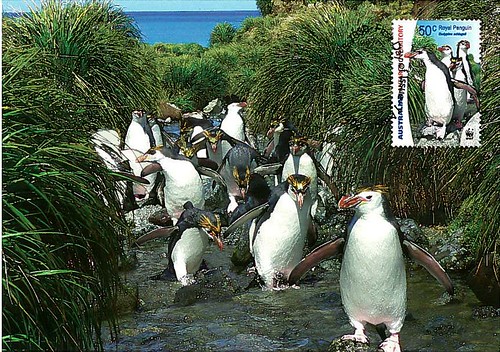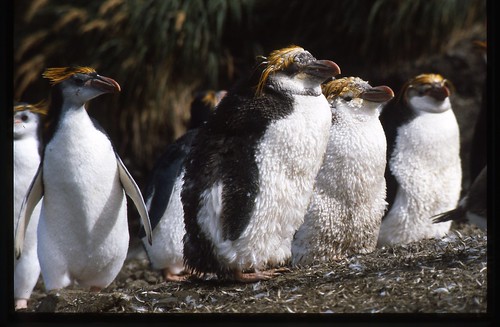


Facts
Kingdom Animalia
Phylum Chordata
Class Aves
Order Sphenisciformes
Family Spheniscidae
Genus Eudyptes (1)
Size Total length: 70 cm (2)
Status:
Classified as Vulnerable (VU A1be+2be, C1) on the IUCN Red List 2003 (1)
Description
Royal penguins differ from the other crested penguins by having white or pale grey faces and chins (3). They have black crowns, backs and flippers flecked with white; short, stubby orange bills and sulphur-yellow crests above the eyes that join at the top of the head (4). Female birds are slightly smaller than the males, but otherwise, the sexes are similar (5). Royal penguins are sometimes confused with the Macaroni penguin (black chin and face), and some authorities consider the Royal a subspecies of the Macaroni (3).
Range
Royal penguins are migratory birds and outside of the breeding season are believed to spend their time in the southern seas between Australia and Antarctica. Their main breeding site is on Macquarie Island, situated roughly half-way between Tasmania and Antarctica, and managed by the Australian state of Tasmania (6). However, they were also recorded in the past as breeding in smaller numbers on New Zealand's South Island and Campbell Island (4).
Habitat
The most important land habitat for the Royal penguin is Macquarie Island, which is dotted with rocks, tussock grass and small shrubs. The birds spend about seven months of the year in the coastal waters around this island (6).
Biology
The Royal penguins' breeding season extends from September to March and starts with the male birds coming ashore on Macquarie Island to build their nests, which are lined with grass and stones (5). The females arrive a couple of weeks later and courtship takes place. Males swing their heads up and down and call to encourage the females to become receptive to mating (5). Eventually, two eggs are laid at the end of October, the second egg being the only one that is usually incubated (5).
Royal penguins are monogamous and often form large colonies of up to 500,000 birds (5), together with the closely related rockhopper penguins. The nests are usually placed a few hundred metres from the sea and the birds make access routes through the tussock grass (4). Incubation lasts from 30-40 days (5), after which the male guards the chick for up to three weeks while the female provides food (4) (5). After this period, the demands of the chick make it necessary for both parents to collect food, and the chicks usually gather together in small crèches (4).
Royal penguins feed largely on krill, small shrimp-like crustaceans, the rest of their diet comprising fish and squid. The parent birds regurgitate partially-digested food from their stomachs to feed their growing youngster (2). When it reaches some 70 days old, the chick will have fledged and can begin to fend for itself. It becomes sexually mature at one year (5).
Threats
Once the subject of a lucrative oil industry in the latter part of the 19th century, Royal penguins are now protected at their breeding sites (5). The main threats come from south polar skuas, Stercorarius maccormicki, which take both eggs and unprotected young (4). There is an additional risk from the fact that as the birds' breeding range is so restricted, a natural or man-made disaster could easily wipe out this species (5).
Conservation
The current world population of the Royal penguin is believed to be stable at around 850,000 pairs (2) (5). There are a number of studies taking place to discover more about the migratory habits of the bird, and their main breeding site, Macquarie Island, enjoys protected status from the Tasmanian government.
Further Information
International Penguin Conservation:
http://www.penguins.cl/royal-penguins.htm
Birdlife International (2003) Birdlife's on-line World Bird Database: the site for bird conservation. Version 2.0. Cambridge, UK: Birdlife International:
http://www.birdlife.org/datazone/species/index.html?action=SpcHTMDetails.asp&sid=3858&m=0
References
1. IUCN Red List (April, 2004)
http://www.redlist.org
2. International Penguin Conservation (April, 2004)
http://www.penguins.cl/royal-penguins.htm
3. Birdlife International (2003) Birdlife's on-line World Bird Database: the site for bird conservation. Version 2.0. Cambridge, UK: Birdlife International (April, 2004)
http://www.birdlife.org/datazone/species/index.html?action=SpcHTMDetails.asp&sid=3858&m=0
4. Sparks, J. and Soper, T. (1968) Penguins. David and Charles, Newton Abbott.
5. Animal Diversity Web, University of Michigan Museum of Zoology (April, 2004)
http://animaldiversity.ummz.umich.edu/site/accounts/information/Eudyptes_schlegeli.html
6. Department of Primary Industries, Water and Environment, Tasmanian Government (April, 2004)
http://www.dpiwe.tas.gov.au/inter.nsf/WebPages/UTAR-52X96F?open
Information courtesy of ARKive@
http://www.arkive.org/royal-penguin/eudyptes-schlegeli/info.html
Pictures from Flickr

















No comments:
Post a Comment